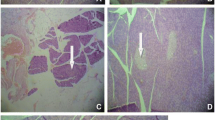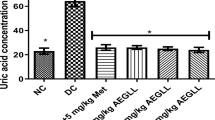Abstract
Purpose
In this study, antihyperglycaemic and level of gene expression of glucose transporters in alloxan-induced diabetic rats administered aqueous extract of S. macrocarpon leaves were assessed.
Method and results
Diabetes was induced by a single intraperitoneal (I.P) injection of freshly prepared alloxan. The animals were divided into six groups, euthanized on the fourteenth day of the experiment and different hyperglycaemic parameters were evaluated. Administration of different doses of the plant extract significantly (p < 0.05) reduced the fasting blood glucose level, glycated haemoglobin, serum lipid profiles, lipid peroxidation, and glucose-6-phosphatase. There was a significant (p < 0.05) increase in liver glycogen content, antioxidant enzyme activities, hexokinase activity, and expression of glucose transporter genes (GLUT-2 and GLUT-4) in diabetic rats administered different doses of S. macrocarpon.
Conclusion
It can be concluded that the aqueous extract of S. macrocarpon leaves could be helpful in the management of diabetes mellitus and its metabolic complications.









Similar content being viewed by others
References
Nelson JE, Cox CE, Hope AA, Carson SS (2010) Chronic critical illness. Am J Respir Crit Care Med 182(4):446–454
Rambabu K, Kumar PS, Kameswari P (2014) Textbook of biochemistry, 2nd edn. AITBS Publishers, New Delhi
Abdalla HI, Abugabal NS, Hassan AZ, El-Safty MM, Shalaby NMM (2012) Antiviral activity of Aloe hijazensis against some hemagglutinating viruses infection and its phytoconstituents. Arch Pharmacal Res 35:1347–1354
Denton OA, Nielsen I, Grubben GJH (2004) Plant resources of Tropical Africa 2. Nord J Bot 23:298–298
Onuora EEO, Okafor CN (2016) Efficacy of extracts of African eggplant and Okra leaves on alloxan-induced diabetes mellitus adult male albino rats. Pak J Nutr 15:551–555
Adewale OB, Onasanya A, Fadaka AO, Iwere H, Anadozie SO, Osukoya OA, Olayide II (2014) In vitro antioxidant effect of aqeous extract of Solanum macrocarpon leaves in rat liver and brain. Oxid Antioxid Med Sci 3:225–229
Dougnon TV, Bankolé HS, Klotoé JR, Sènou M, Fah L, Koudokpon H, Akpovi C, Dougnon TJ, Addo P, Loko F, Boko M (2014) Treatment of hypercholesterolemia: screening of Solanum macrocarpon Linn (Solanaceae) as a medicinal plant in Benin. Avicenna J Phytomed 4:160–169
Ajiboye BO, Akalabu MC, Ojo OA, Afolabi OB, Okesola MA, Olayide I, Oyinloye BE (2018) Inhibitory effect of ethyl acetate fraction of Solanummacrocarpon L. leaves on cholinergic, monoaminergic, and purinergic enzyme activities. J Food Biochem 42:e12643
Ajiboye BO, Ojo OA, Adeyonu O, Imiere O, Olayide I, Fadaka A, Oyinloye BE (2016) Inhibitory effect on key enzymes relevant to acute type-2 diabetes and antioxidative activity of ethanolic extract of Artocarpus heterophyllus stem bark. J Acute Dis 5:423–429
Islam SM, Niessen LW, Seissler J, Ferrari U, Biswas T, Islam A, Lechner A (2015) Diabetes knowledge and glycemic control among patients with type 2 diabetes in Bangladesh. SpringerPlus 4:284
Ojo O, Ajiboye BO, Oluwatosin DI, Adeyonu O, Olayide I, Fadaka AO (2018) Antioxidative properties of Blighiasapida K. D. Koenig stem bark extract and inhibitory effects on carbohydrate hydrolyzing enzymes associated with non-insulin dependent diabetes mellitus. Pharmacogn J 10:376–383
Ahmad MS, Pischetsrieder M, Ahmed N (2007) Aged garlic extract and S-allyl cysteine prevent formation of advanced glycation endproducts. Eur J Pharmacol 561:32–38
Eastham RD (1985) Biochemical values in clinical medicine, 7th edn. John Wright and Sons, Bristol
Tietz NW (1995) Clinical guide to laboratory tests, 3rd edn. W.B. Saunders Company, Philadelphia, pp 518–519
Trinder P (1969) Estimation of triglyceride in blood GPO-PAP enzymatic method. Am J Clin Biochem 6:24–27
Friedewald WT, Levy RI, Fredrickson DS (1972) Estimation of the concentration of low-density lipoprotein cholesterol in plasma, without use of the preparative ultracentrifuge. Clin Chem 18:499–502
Akinyosoye F, Fawole M, Akinyanju J (1987) Studies on some enzymes of carbohydrate metabolism in Geotrichum candidum. Niger J Microbiol 7:154–161
Baginski SE, Foà PP, Zak B (1974) Glucose-6-phosphatase. Methoden der enzymatischen Analyse 1:839–843
Elekofehinti OO, Ariyo EO, Akinjiyan OS, Lawal AO, Adanlawo IG, Joao BL (2018) Potential use of bitter melon (Momordica charantia) derived compounds as antidiabetics: in silco and in vitro studies. Pathiophysiology 25:327–333
Holness MJ, Palmer TN, Sugden MC (1988) Suppression of hepatic glucose output after glucose re-feeding in the gsd/gsd rat. Biochem J 252:928–929
Varshney R, Kate R (1990) Effects of calmodulin antagonists on radiation-induced lipid peroxidation in microsomes. Int J Radiat Biol 58:733–743
Misra HP, Fridovich I (1972) The role of superoxide anion in the autooxidation of epinephrine and simple assay for superoxide dismutase. J Biol Chem 247:3170–3175
Sinha AK, Kurtz M, Bhattacharjee JK (1971) Effect of hydroxylysine on the biosynthesis of lysine in saccharomyces. J Bacteriol 108:715–719
Paglia DE, Valentine WN (1967) Studies on the quantitative and qualitative characterization of erythrocyte glutathione peroxidase. J Lab Clin Med 70:158–169
Szkudelski T (2001) The mechanism of alloxan and streptozotocin action in B cells of the rat pancreas. Physiol Res 50:536–546
DeFronzo RA, Bonadonna RC, Ferrannini E (1992) Pathogenesis of non insulin dependent diabetes mellitus. Diabetes Care 1992(3):318–368
Mironova MA, Klein RL, Virella GT, Lopes-Virella MF (2000) Antimodified LDL antibodies, LDL-containing immune complexes and susceptibility of LDL to in vitro oxidation in patients with type-2 diabetes. Diabetes 49:1033–1041
Martirosyan DM, Miroshnichenko LA, Kulakova SN, Pogojeva AV, Zoloedov VI (2007) Amaranth oil application for coronary heart disease and hypertension. Lipids Health Dis 6:1
Zicha J, Kunes J, Devynck MA (1999) Abnormalities of membrane function and lipid metabolism in hypertension. A review. Am J Hypertens 12:315–331
Grover JK, Vats V, Rathi SS (2000) Anti-hyperglycemic effect of Eugenia jambolana and Tinospora cordifolia in experimental diabetes and their effects on key metabolic enzymes involved in carbohydrate metabolism. J Ethnopharmacol 73:461–470
Lekshmi RK, Rajesh R, Mini S (2015) Ethyl acetate fraction of Cissus quadrangularis stem ameliorates hyperglycaemia-mediated oxidative stress and suppresses inflammatory response in nicotinamide/streptozotocin induced type 2 diabetic rats. Phytomedicine 22:952–960
Yechoor VK, Patti ME, Saccone R, Kahn CR (2002) Coordinated pattern of gene expression for substrate and energy metabolism in skeletal muscle of diabetic mice. Proc Natl Acad Sci USA 99:10587–10592
Kim S, Gailite I, Moussian B, Luschnig S, Goette M, Fricke K, Honemann-Capito M, Grubmüller H, Wodarz A (2009) Kinase-activity-independent functions of a typical protein kinase C in Drosophila. J Cell Sci 122:3759–3771
Naik P (2011) Biochemistry textbook, 3rd edn. Jaypee Brothers Medical Publishers Ltd, New Delhi
Raju J, Gupta D, Rao AR, Yadava PK, Baquer NZ (2001) Trigonell afoenum graecum (fenugreek) seed powder improves glucose homeostasis in alloxan-diabetic rat tissues by reversing the altered glycolytic, gluconeogenic and lipogenic enzymes. Mol Cell Biochem 224:45–51
Kumar V, Ahmed D, Verma A, Anwar F, Ali M, Mujeeb M (2013) Umbelliferone β-d-galactopyranoside from Aeglemarmelos (L.) corr. an ethnomedicinal plant with antidiabetic, antihyperlipidemic and antioxidative activity. BMC Complement Altern Med 13:273
Acknowledgements
The authors wish to express their gratitude to the support received by the South African Medical Research Council (SAMRC) through funding received from the South African National Treasury. Also, its contents are mainly the responsibility of the authors and do not necessarily represent the official views of the South African Medical Research Council.
Funding
This study was supported by the South African Medical Research Council through funding collected from the South African National Treasury.
Author information
Authors and Affiliations
Corresponding author
Ethics declarations
Conflict of interest
The authors hereby declare no conflict of interest.
Research involving human participants and/or animals
This study was done following the Animal Ethical Committee of Afe Babalola University, Ado-Ekiti, Ekiti State, Nigeria.
Informed consent
For this type of study, informed consent is not required.
Additional information
Publisher's Note
Springer Nature remains neutral with regard to jurisdictional claims in published maps and institutional affiliations.
Rights and permissions
About this article
Cite this article
Ajiboye, B.O., Oyinloye, B.E., Owero-ozeze, O.S. et al. Aqueous extract of Solanum macrocarpon Linn leaves abates hyperglycaemia and expression of glucose transporters gene in alloxan-induced diabetic rats. J Endocrinol Invest 44, 265–276 (2021). https://doi.org/10.1007/s40618-020-01280-y
Received:
Accepted:
Published:
Issue Date:
DOI: https://doi.org/10.1007/s40618-020-01280-y




